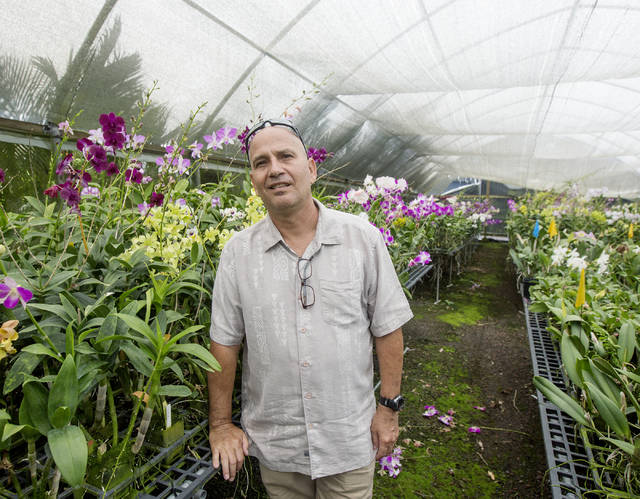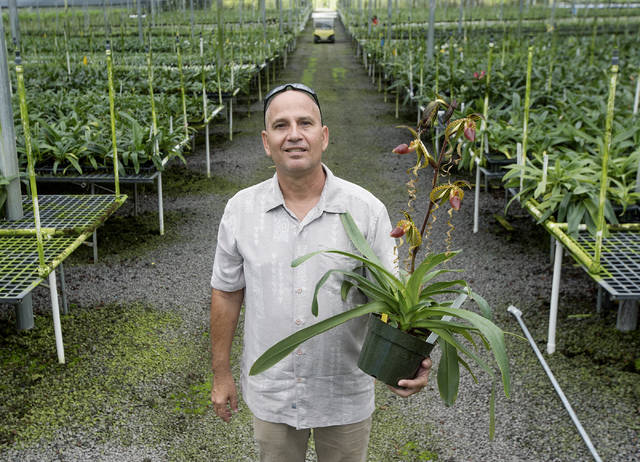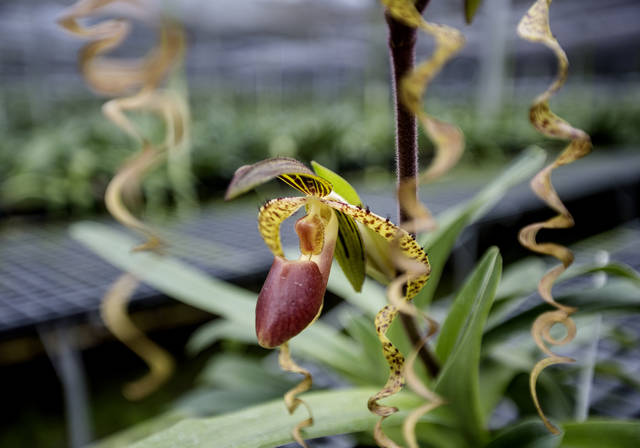HILO — International competition and retirements are decreasing the number of commercial orchid growers in Hawaii. ADVERTISING HILO — International competition and retirements are decreasing the number of commercial orchid growers in Hawaii. “I do have concerns for the commercial
HILO — International competition and retirements are decreasing the number of commercial orchid growers in Hawaii.
“I do have concerns for the commercial orchid growers, not in the next few years, but in the next decade,” said Elton Mow, president of the Orchid Growers Association of Hawaii and chair of the research and education committee of the Hawaii Floriculture and Nursery Association.
International competition is tough and getting tougher, industry insiders say. Growers say some of their peers are leaving, or in danger of leaving, the market. Hawaii, they say, needs to reinvent the orchid industry through hybridization of new orchids — and marketing — to keep it sustainable.
In 2011, there were 225 growers of various orchid types in the state, including potted plants and cut flowers, according to data from the U.S. Department of Agriculture.
By 2015, the latest year data is available, just 190 growers contributed sales to those same categories.
“The international competition — it’s a big part of it,” Mow said.
Jeffrey Newman, owner of Newman’s Nursery Inc., said the USDA’s approval of additional orchid imports to the U.S. in March 2016 has opened a flood of shipments from countries like Taiwan.
“It’s an issue,” he said. “They’re just shipping them in containers to the mainland.”
Originally, Newman said, only one type of orchid had approval for import from Taiwan. But he believes many more approvals are on the horizon.
“I don’t know what the ramifications will be down the line,” said Newman, whose Hawaiian Paradise Park nursery employs 30 people.
China, South Korea and Costa Rica are preparing to follow Taiwan’s lead in the orchid market, creating even more competition for Hawaii growers, Newman said.
Now that Taiwan has approval to import a certain variety of potted orchid, he said, “they’re just going to keep going down the line until they get them all.”
International orchid growers, Newman said, have started setting up their own operations on the mainland. They ship in plant “plugs” (small “starts” that are ready to be grown to adulthood) to New York, California, Texas and Colorado, he said, and then finish growing the plants until they’re ready for market.
The starts can be grown cheaply in bulk internationally and then shipped to the mainland.
“It’s not a good thing,” Newman said. “I don’t know how they can sell orchids that cheap. They sell them dirt-cheap.”
At least two East Hawaii commercial orchid growers have abandoned orchids altogether recently.
One switched from orchid farming to cattle ranching. That grower did not reply to calls for comment. The other agreed to be quoted if his former company’s name is not mentioned.
“As competition grows from the foreign country, America always loses,” the former commercial orchid grower said.
Since the 1980s, the cost for supplies and shipping has increased, the grower said, but the price growers could charge for the plants and cuttings the mom-and-pop business produced stayed essentially the same.
“We did employ people. We did propagate a lot of plants. But it’s time to move on,” the former grower said.
Thong Teng Neo, who tends the orchids at Greenpoint Nurseries between Panaewa and Keaau, said there are a lot of factors to look at when considering the viability of orchid growing.
“We have to reinvent ourselves, the industry, and encourage new farmers,” he said.
At Greenpoint, he said, “the next generation is coming in. The next 40 years, we know somebody’s going to continue.”
But, for many commercial orchid growers with children, the income is not good enough to convince young adults to continue the business.
Greenpoint grows many types of plants and flowers, in addition to orchids, which helps provide a stronger financial base for orchid growers by diversifying their products.
Mow said Taiwan had to ship orchids bare-root before the USDA approved opening the market to importation. That was more difficult because the bare-root method leaves the plants open to injury. Pots and soil of potted plants have more places for potentially invasive insects to hide, Mow said.
A lawsuit to block Taiwan from importing potted orchids, he said, “probably delayed the approval.” But, in the end, the lawsuit, in 2005, failed to block the USDA’s action.
Hawaii orchid growers can’t compete against international producers who can grow a million orchid plugs in one greenhouse, Mow said. Instead, he said, key to Hawaii growers’ success will be a combination of plant hybridization to make new, available-only-from-Hawaii plants and marketing to make clear the high quality and uniqueness of Hawaii-grown orchids.
Investing in that effort now has potential to pay off in the future. But it’s also risky because international growers might out-compete Hawaii by doing the same things.
“It’s a type of gambling, like all farming is,” Mow said.
Identifying orchids as high quality, Hawaii-grown plants will increase their pricing potential, he said. And hybridization of new varieties of orchids not available elsewhere also has potential to reward Hawaii growers financially.
But, Mow said, “we need to work — now — to brighten our future.”
Email Jeff Hansel at jhansel@hawaiitribune-herald.com.





